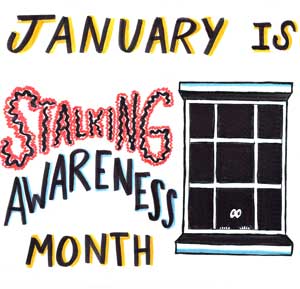The staff editorial is the majority opinion of The Murray State News Editorial Board.

We ignore the warning signs. We delete friend request after friend request and lock down our social media accounts. We ignore phone calls, delete texts and block numbers. We pretend it’s not their car that just drove by – that it’s just a coincidence. We ignore the feeling that someone is watching us.
We take a scary situation and we belittle it until we have feigned some sense of safety. But this isn’t the Boogey Man – we can’t hide under the covers and hope it doesn’t hurt us.
Stalking is a crime, and it should be treated as such.
A recent report by the Centers for Disease Control and Prevention revealed that 7.5 million United States citizens are stalked every year. According to StalkingAwarenessMonth.org, of those 7.5 million, people ages 18-24, experience the highest rates of stalking victimization.
We, as college students, are the most vulnerable.
The line between Facebook “creeping” and genuine stalking is getting thinner and thinner, blurrier and blurrier. Online stalking isn’t contained by some invisible Internet fence.
Reality is reality, and with stalking, there’s nothing virtual about it.
Most of us have been putting our lives online for the world to see ever since our fingers could move.
Step 1: Learn how to walk.
Step 2: Learn how to type.
Step 3: Find out that you already have 5,000 baby pictures of yourself on the Internet.
Step 4: Learn how to use said Internet anyway because nothing can go wrong.
The fact that technology is such a largely integrated part of our lives means a ton of potentially awful things; people have the resources to know everything about us before ever meeting us.
According to StalkingAwarenessMonth.org, more than 25 percent of stalking victims report technology being used in their stalking. More and more, stalkers are using technology to their advantage – to see what you’re doing online, to track your location, to look at your pictures, etc.
Yet again, our moms and professors were right: be careful what you post on the Internet.
Also, be careful who you let into your life.
According to The National Center for Victims of Crime, 44 percent of male victims and 61 percent of female victims report being stalked by a former or current intimate partner.
This is really where not belittling or minimizing the severity of your situation comes into play. Despite whatever they used to mean to you or how much faith you have in the notion that they would never actually harm you, if their behavior is suspicious and threatening, it could escalate very quickly.
As we’ve said, stalking is a crime – treat it as such. Go to the police and tell the authorities that there is a serious threat to your safety.
According to StalkingAwarenessMonth.org, 59 percent of female stalking victims and 63 percent of male stalking victims neglect to report their situation to authorities.
If you are being stalked or even think you’re being stalked, please know these facts: your situation is serious, the behavior is criminal and the police will take it seriously.
Also, while technology can be our enemy, it can also be a life-saving aid.
Download the LiveSafe app, provided by Murray State. Not only can you report suspicious activity with the tap of a finger, but your friends and family can monitor your walk home with the SafeWalk feature to ensure you don’t stray from your usual path and, most importantly, that you arrive at your destination safely.
Your life is valuable and any threat to it should not be taken lightly.




























































































